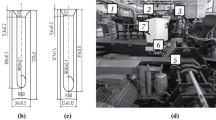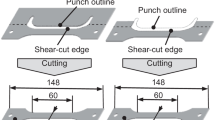Abstract
In sheet-forming operations, it has been sought to always obtain the maximum elongation of the material without the occurrence of defects, a condition that is of fundamental importance to know the performance of the sheet metal in industrial processes. In view of this need, the FLCs (forming limit curves) of the used metal sheets are determined, which provide an excellent condition for the evaluation of the material stamping limit. Deformation levels lower than FLC, considering a safety margin, are considered satisfactory in industrial operations. Based on this, the objective of this work was the adequacy of a test machine and the development of a method to obtain the FLC of sheet metal at the beginning of the material’s bonding, thus seeking a more precise result of the formability of the main steels used in the industry, advanced high strength steels. For this, an initial analysis of the hydraulic press was carried out where, taking advantage of the displacement and oil pressure sensors present, a new control program was determined in the PLC (programmable logic controller), to parameterize the points that precede the rupture of the sheet during the stamping test. Under these conditions, the FLC of the dual-phase steel DP600 was determined until its rupture and, later, until the point of its beginning, which allowed the definition of the real limit of formability of this material. In addition to the conclusion regarding the behavior of the material, considering the industrial processes, the results obtained also allow the determination of set points of machines more adequate to the limits of deformation of the sheet metal used. The FLC presented a variation, characterized by a small increase in the formability limit for the tests with hydraulic press temperature control conditions. The results highlighted higher temperatures on the pump, followed by the distributing block and the pressure sensor, concluding that the major influence critical point on the FLC result was the hydraulic pump.









Similar content being viewed by others
References
Keeler S, Kimchi M (2015) Advanced high-strength steels application guidelines V5. WorldAutoSteel
Andrade SL, PEREIRA J, TAISS EUA (2000) O aço no automóvel do futuro: A estratégia da Usiminas. Contribuição técnica ao 55º Congresso Anual da ABM. Rio de Janeiro/RJ 55
Abeyrathna B, Rolfe B, Hodgson P, Weiss M (2016) A first step towards a simple in-line shape compensation routine for the roll forming of high strength steel. Int J Mater Form 9:423–434
Olavo, H (2017) (Porto Alegre). 37th S e N A F O R. Influência da geometria do quebra-rugas na factibilidade do processo de estampagem com base no Método dos Elementos Finitos: Influence of drawbead geometry on stamping feasibility based on Finite Elements Method. Disponível em: http://www.2017.senafor.com/conteudo/view?ID_CONTEUDO=442. Accessed 4 2017
Ke J, Liu Y, Zhu H, Zhang Z (2018) Formability of sheet metal flowing through drawbead–an experimental investigation. J Mater Process Technol 254:283–293
Schmid H, Hetz P, Merklein M (2019) Failure behavior of different sheet metals after passing a drawbead. Procedia Manuf 34:125–132
Barlo, A., Sigvant, M., & Endelt, B. (2019). On the failure prediction of dual-phase steel and aluminium alloys exposed to combined tension and bending. In IOP Conference Series: Materials Science and Engineering Vol. 651, No. 1, 012030 IOP Publishing
Keeler SP (1965) Determination of forming limits in automotive stampings (No. 650535). SAE technical paper
Goodwin GM (1968) Application of strain analysis to sheet metal forming problems in the press shop. SAE Trans:380–387
Woodthorpe J, Pearce R (1969) effect of R and N upon the forming limit diagrams of sheet steel. Sheet Metal Ind 46(12):1061–1067
Min J, Stoughton TB, Carsley JE, Lin J (2016) Compensation for process-dependent effects in the determination of localized necking limits. Int J Mech Sci 117:115–134
Emanuela A, Marion M (2017) Metallographic analysis of Nakajima tests for the evaluation of the failure developments. Procedia Eng 183:83–88
Iquilio RA, Cerda FC, Monsalve A, Guzmán CF, Yanez SJ, Pina JC et al (2019) Novel experimental method to determine the limit strain by means of thickness variation. Int J Mech Sci 153:208–218
Shinmiya, T., Fujii, Y., Yamasaki, Y., & Tamai, Y. (2019). Investigation of crack prediction method using limiting surface strain in high-strength steel sheets. In IOP Conference Series: Materials Science and Engineering Vol. 651, No. 1, 012065 IOP Publishing
Norz R, Volk W (2019) Investigation of non-proportional load paths by using a cruciform specimen in a conventional Nakajima test. In: IOP Conference Series: Materials Science and Engineering, vol 651, No. 1. IOP Publishing, p 012020
Jocham D, Gaber C, Böttcher O, Volk W (2015) Prediction of formability for multi-linear strain paths. Proc. Of FTF 2015:59–64
Chemin Filho RA, Valente Tigrinho LM, Barreto Neto RC, Marcondes PVP (2013) An experimental approach for blankholder force determination for DP600 with different material flow strain rates in the flange during stamping. Proc Inst Mech Eng B J Eng Manuf P I Mech Eng B-J Eng 227(3):417–422
Lajarin SF, Marcondes PV (2015) Influence of process and tool parameters on springback of high-strength steels. Proc Inst Mech Eng B J Eng Manuf P I Mech Eng B-J Eng 229(2):295–305
Tigrinho LMV, Santos RAD, Chemin Filho RA, Marcondes PVP (2008) Experimental investigation on the influence of the lubricant type in the punch stretching of extra deep-drawing steel. J Braz Soc Mech Sci Eng 30:290–294
Valente Tigrinho LM, Chemin Filho RA, Prestes Marcondes PV (2013) Fracture analysis approach of DP600 steel when subjected to different stress/strain states during deformation. Int J Adv Manuf Technol 69:1017–1024
Paul SK (2021) Controlling factors of forming limit curve: a review. Adv Indust Manuf Eng 2:100033
Paul SK (2016) Prediction of complete forming limit diagram from tensile properties of various steel sheets by a nonlinear regression based approach. J Manuf Process 23:192–200
Paul SK (2020) A critical review on hole expansion ratio. Materialia 9:100566
Huh H, Kim SB, Song JH, Lim JH (2008) Dynamic tensile characteristics of TRIP-type and DP-type steel sheets for an auto-body. Int J Mech Sci 50(5):918–931
Curtze S, Kuokkala VT, Hokka M, Peura P (2009) Deformation behavior of TRIP and DP steels in tension at different temperatures over a wide range of strain rates. Mater Sci Eng A 507(1-2):124–131
Farabi N, Chen DL, Li J, Zhou Y, Dong SJ (2010) Microstructure and mechanical properties of laser welded DP600 steel joints. Mater Sci Eng A 527(4-5):1215–1222
Uthaisangsuk V, Prahl U, Bleck W (2011) Modelling of damage and failure in multiphase high strength DP and TRIP steels. Eng Frac Mech 78(3):469–486
Kim SB, Huh H, Bok HH, Moon MB (2011) Forming limit diagram of auto-body steel sheets for high-speed sheet metal forming. J Mater Process Technol 211(5):851–862
Nikhare C, Marcondes PV, Weiss M, Hodgson PD (2008) Experimental and numerical evaluation of forming and fracture behaviour of high strength steel. In: Proc. Of New Developments on Metallurgy and Applications of High Strength Steels. Buenos Aires, Argentina pp 26–28
De Araujo Bornancin RM, Nikhare CP, Marcondes PVP (2023) Numerical comparison of advanced high strength steels forming limit curve using Banabic and Nakazima tests. Int J Interact Des Manuf:1–10. https://doi.org/10.1007/s12008-023-01218-7
ISO (2008) Metallic materials-sheet and strip-determination of forming-limit curves-part 2: determination of forming-limit curves in the laboratory. ISO
Availability of data and material
Not applicable.
Code availability
Not applicable.
Funding
This research was funded by the Siderúrgica ArcelorMittal S/A (DP780 supply) and the CNPq (Brazil).
Author information
Authors and Affiliations
Corresponding author
Ethics declarations
Ethics approval
Not applicable.
Consent to participate
Not applicable.
Consent for publication
Not applicable.
Conflict of interests
The authors declare no competing interests.
Additional information
Publisher’s note
Springer Nature remains neutral with regard to jurisdictional claims in published maps and institutional affiliations.
Rights and permissions
Springer Nature or its licensor (e.g. a society or other partner) holds exclusive rights to this article under a publishing agreement with the author(s) or other rightsholder(s); author self-archiving of the accepted manuscript version of this article is solely governed by the terms of such publishing agreement and applicable law.
About this article
Cite this article
de Lima, E., do Nascimento Cruz, M., Filho, R.A.C. et al. Influence of the hydraulic press system on advanced high-strength steel formability. Int J Adv Manuf Technol 127, 615–624 (2023). https://doi.org/10.1007/s00170-023-11578-9
Received:
Accepted:
Published:
Issue Date:
DOI: https://doi.org/10.1007/s00170-023-11578-9




